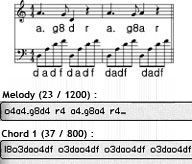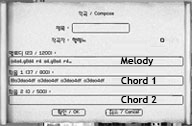- Introduction to Music Composition -
Written by Baird
Contents
1. Preface
2. Scales
3. Rhythm
4. Other Components for Composing
5. Using Harmony
6. Conclusion
1. Preface
The process of composing music is a collaboration of both reason and emotion.
Therefore, it is impossible to explain or understand this process through reason alone.
The melody that flows within you can be heard in the whisper of your soul's gentle voice, the crashing waves of the ocean and in the silent consciousness of the universe.
However, transferring that melody into a sequence of notes on a piece of paper is a meticulous task.
This book is written to help readers learn how to express their emotions through composing music. It will greatly benefit those who have wanted compose but haven't learned how.
2. Scales

The scale refers to the pitch of a note, how high or low the note is.
It is expressed through the following symbols.
C : Do
D : Re
E : Mi
F : Fa
G : Sol
A : La
B : Ti
3. Rhythm

Rhythm refers to the duration of a note, how long or short the note is.
It is expressed through the following symbols.
Whole Note : 1
Quarter Note : 4
Eighth Note : 8
Sixteenth Note : 16
Thirty-Second Note : 32
Sixty-Fourth Note : 64
Dotted Note :
Add a [.], following the number.
ex) 16. : Dotted Sixteenth Note
4. Other Components for Composing

Besides scales and rhythm, there are other components you must learn in order to compose a beautiful song..
Rn (Rest) : n=1~64, Rest
On (Octave) : n=1~8, O4 is default value
Tn (Tempo) : n=32~255, Change tempo. T120 is default value
Ln (Duration) : n=1~64,
Assigning the duration of notes.
L8 ceg is the same as c8e8g8. L4 is the default value.
Nn (Note) : n=0~96,
Assign the note's pitch.
Vn (Volume) : n=0~15, Volume for each channel.
5. Using Harmony

If you are already familiar with harmonics, try using it in your composition.
When you use the Compose skill and open your sheet music, you will notice that you can select Chord 1 and Chord 2 to play separately. Using this, you can create a 3 part harmony.
Just make sure that the melody, and the chord's rhythm and note fit together.
6. Conclusion
It will be difficult to compose long scores in the beginning.
But if you continue to practice, you will be able to compose longer songs, no problem.
Who knows? You just might discover the musician inside you. 


